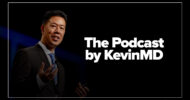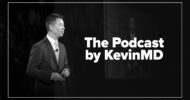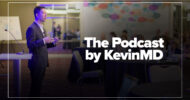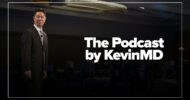Subscribe to The Podcast by KevinMD. Watch on YouTube. Catch up on old episodes!
Health care executive Sujay Jadhav discusses his article “How AI is revolutionizing health care through real-world data.” Sujay explains how artificial intelligence tools like machine learning and natural language processing are turning unstructured electronic health record data into actionable insights that accelerate clinical research, drug development, and patient care. He highlights how AI can expand research cohorts, improve trial efficiency, and drive personalized medicine while stressing the importance of high-quality data curation, oversight, and multidisciplinary collaboration to avoid bias and ensure accuracy. Listeners will take away practical perspectives on how real-world data is reshaping diagnostics, treatment plans, and the future of health care.
Our presenting sponsor is Microsoft Dragon Copilot.
Want to streamline your clinical documentation and take advantage of customizations that put you in control? What about the ability to surface information right at the point of care or automate tasks with just a click? Now, you can.
Microsoft Dragon Copilot, your AI assistant for clinical workflow, is transforming how clinicians work. Offering an extensible AI workspace and a single, integrated platform, Dragon Copilot can help you unlock new levels of efficiency. Plus, it’s backed by a proven track record and decades of clinical expertise, and it’s part of Microsoft Cloud for Healthcare, built on a foundation of trust.
Ease your administrative burdens and stay focused on what matters most with Dragon Copilot, your AI assistant for clinical workflow.
VISIT SPONSOR → https://aka.ms/kevinmd
SUBSCRIBE TO THE PODCAST → https://www.kevinmd.com/podcast
RECOMMENDED BY KEVINMD → https://www.kevinmd.com/recommended
Transcript
Kevin Pho: Hi, and welcome to the show. Subscribe at KevinMD.com/podcast. Today we welcome Sujay Jadhav. He’s a health care executive. Today’s KevinMD article is “How AI is revolutionizing health care through real-world data.” Sujay, welcome to the show.
Sujay Jadhav: Thanks, Kevin. Excited to be here.
Kevin Pho: Let’s start by briefly sharing your story and then talk about the KevinMD article that you shared with us today.
Sujay Jadhav: My background is that I was born into a family of physicians. My father was a physician, a psychiatrist, and growing up, I was surrounded by physicians, given most of my family members were in the industry. I supported him on weekends from an administration perspective, so I got great insights into the care elements but also the somewhat burdensome administration elements of running a practice.
I was the rebel; I decided to do engineering. But as things go in life, straight after business school, I joined a digital health company, and I’ve been in the industry for almost 30 years now. I’ve been very fortunate that I’ve been part of three successful companies.
With each company, I’ve managed to get closer and closer to impacting patient care. The first company was a company called Model N, where we helped deal with pricing for life sciences and biotech companies. The second company, Alto, helped focus on automating the early part of the clinical trial process and helping optimize it so that you can spend more time recruiting patients and quality patients into clinical trials. Now at Ana, I can leverage all this expertise, both on the commercial side and the clinical trial side, with a key focus on quality of care and a focus on real-world data.
Kevin Pho: I’m always interested in hearing a variety of perspectives when it comes to that AI and health care intersection. There are so many avenues that we can explore. Your KevinMD article is “How AI is revolutionizing health care through real-world data.” For those that didn’t get a chance to read your article, tell us what it’s about.
Sujay Jadhav: Looking at AI currently, there’s commentary around how it is the latest buzzword. I’ll say inherent in that comment is a little bit of shallowness with regard to how AI is leveraged currently. But the overarching purpose of the article is to talk through how AI is here today. It is transforming things all the way from the health care to life sciences continuum, and I set a number of examples of how we are leveraging AI to make a meaningful impact across that particular continuum.
The focus is on real-world data and particularly unstructured data, where we feel we can uncover a lot of insights to help improve quality of care and to help improve research. In terms of quality of care, at Ana, we help provide this mixed service in partnership with societies in the specialty areas that we focus on, such as ophthalmology and urology.
In essence, this service we provide is to help support the specialists in terms of submitting quality-of-care metrics to CMS. This allows them to have bonuses and also avoid penalties. Now, historically, the way these calculations were done was on structured data, and that has a limitation in terms of understanding the true overall quality of care. In the last couple of years, we have expanded it to unstructured data, where we are leveraging NLP and machine learning techniques on physician notes, as an example, to uncover quality-of-care dynamics that are occurring and allow the physician to submit that to CMS to help maximize the bonuses that they can get.
Another area where we are leveraging unstructured data and machine learning techniques is helping identify and diagnose patients with specific diseases. What we are finding in areas such as urology, for example, is that by leveraging these particular techniques, we’re yielding cohorts of patients five times larger versus normal structured data analysis. Secondly, in ophthalmology, looking at imaging data and identifying patients with geographic atrophy earlier on yields very large cohort sizes, which ultimately leads to helping address those particular patients with that disease, slow the disease progression, and improve overall quality of care.
Kevin Pho: When it comes to unstructured data, you specifically mention ophthalmology. What are some examples of unstructured data that you would typically find in the chart?
Sujay Jadhav: When we look at unstructured data, there are two elements. One is on the imaging side of the house. So, looking at the eye, etc., and understanding certain disease progression there. We’ve built machine learning models that ingest the images and can look at diagnosing particular conditions, such as geographic atrophy, which I mentioned.
These models we’ve developed need to be trained over multiple years to hit that quality factor, which is important to leverage for regulatory and care purposes. But that’s an example of one we’ve been using for a number of years to help diagnose.
Another one is in the glaucoma area, looking in the physician notes at intraocular pressure, or IOP, mentions, understanding reductions or increases in that, and also building machine learning models which look at not just the keywords but also the context around them to ensure that when we suggest that a particular patient has a degradation in, for example, visual acuity related to a particular disease, we’re suggesting it with a high degree of accuracy. So there are a couple of examples of how we are leveraging unstructured data to help surface patients with particular conditions.
Kevin Pho: Now, before AI and natural language tools, how would physicians be able to mine a chart and get some of these measures over to CMS? How was it done before this technology?
Sujay Jadhav: The core way that they would do it is that they would look at the images themselves and look at a lot of the diagnostic reports. Then they would have to categorize it in terms of ICD-10 and ICD-9 codes there. That would be the core of what they would leverage from a coding perspective to then do these particular calculations to then submit it to CMS.
As you can imagine, the variety of sources that you use to get this type of information, leaving it to the human eye, sometimes has a different level of variability. Leaving it to a different set of folks who are involved in the overall health care continuum also provides extra variability there. Hence, when you look at the quality of what was being submitted, it needed to have a lot of validation. A lot of effort went into that, and hence it was very, very cumbersome to submit this to CMS. We are looking to automate most of that particular process, but as I said, this is more of a support that we are providing to our specialists. At the end of the day, we’re not looking to replace the way they diagnose or the way they look at care of these particular patients. What we are doing is surfacing suggestions like, “Hey, these particular set of patients are having improved quality here. You should leverage them for your submission to CMS to generate a particular bonus.” It’s more of a support function that we are providing to the specialists that we support.
Kevin Pho: Can you share some case studies or data in terms of the financial impact that your tool can give in terms of mining the chart for unstructured data so you could send it off to CMS? What kind of examples of financial benefit could there be for the practice?
Sujay Jadhav: Absolutely. We are seeing a couple of things. We’re seeing north of 30 percent in terms of efficiency savings in actually documenting and calculating these quality measures in the way that we’re doing it and automating it. That’s just in the submission process. But when you’re looking at the bonuses that they can generate and avoiding penalties, it can be 6 to 7 percent overall. When you’re looking at practices which are doing hundreds of thousands of dollars, that’s a substantial amount, even sometimes millions of dollars. So we’re seeing in the tens of thousands of dollars, if not one hundred thousand dollars, of impact related to submitting quality measures to help improve the way that they generate these particular bonuses.
Kevin Pho: Now in your article, you also talk about your experience with that intersection within AI and clinical trials and drug development. Tell us about how AI is helping us there.
Sujay Jadhav: Absolutely. As I talked a little bit about, we are mining the physician notes and the images to help do early diagnosis of some of these critical diseases that we have, but we also are leveraging those diagnoses and cohorts of patients for inputs into clinical trials. An example in prostate cancer, as I mentioned, is generating cohorts five times what you would normally get via a structured data analysis. Those particular patients are in the urologist setting, so helping surface them up for urology trials is extremely impactful there.
The early onset of that particular disease, which is a key disease that impacts a number of people in the world, helping provide that group of patients to pharmaceutical companies so they can enroll them in particular trials and then leveraging that data so that they can help optimize their inclusion and exclusion criteria to ensure that when they conduct a trial, they can recruit adequate patients and help improve the overall cost and timeliness. As you can see, the early diagnosis that we’re doing in these critical disease areas is yielding high patient populations and is being an input into clinical trials to optimize that overall process.
One other thing I would add is the beauty of the amount of data that we have currently in AI. We’re actually making a good dent in other areas, such as rare diseases, which historically have not had high patient populations, and also looking at segments of the population which typically have not gotten a large amount of investment, such as pediatrics. With the wealth of data that we have, both structured and unstructured, we can leverage all that data with AI techniques to help support trials in those particular areas where historically it was very, very difficult given the patient populations were very, very small.
Kevin Pho: Now are there any potential risks or pitfalls researchers and clinicians should be aware of when applying AI to real-world health data?
Sujay Jadhav: I would say that, first of all, we’re very, very careful with our particular models in terms of the way we design them. They have specialist clinicians who help design those particular models. As we go through every particular iteration with sample data, they validate that. Then ultimately, when we release the cohort of patients, de-identified for biotech and pharmaceutical companies to leverage, there is a quality gate that we do, which is clinician-led.
But I’ll say the most valuable insights often come from unstructured data. The clinician notes, their observations, and the reports are essential to generating real-world evidence. AI is a tool that just scales the clinician expertise; it’s definitely not a replacement. As I mentioned, clinician input is critical to building and validating these particular models.
Accurate and thorough documentation doesn’t just support care; there are a lot of downstream elements and benefits to it. It fuels research, improves trial design, and helps shape the future of medicine. The beauty of natural language processing, machine learning, and AI is that historically, physicians were forced to learn how to document things in a more standardized fashion. I think there’s no need to do that anymore. With these particular techniques, they can record their observations the way they see fit. But having said that, it needs to be accurate. As long as that’s accurate, then I’m very, very optimistic in terms of how we can improve overall quality of care and research.
Kevin Pho: We’re talking to Sujay Jadhav. He’s a health care executive. Today’s KevinMD article is “How AI is revolutionizing health care through real world data.” Sujay, let’s end with some take-home messages that you want to leave with the KevinMD audience.
Sujay Jadhav: Yeah, absolutely. Hopefully, through this particular discussion and through my article, you know that AI is definitely here. It’s adding a lot of value through the health care to life sciences continuum. I set a number of examples where we are definitely doing that.
AI’s ability to unlock unstructured clinical data is already transforming how we understand disease, deliver care, and conduct research. Success depends entirely on high-quality, clinically validated data, made possible through close collaboration with clinicians who generate it. I will say to the clinician audience out there, there’s definitely a first-mover advantage to leveraging a lot of these AI techniques right now. I’m very optimistic given the number of solutions out there, whether it’s EHR-dependent or third parties that are AI-focused, that there are going to be a lot of opportunities for clinicians to leverage this to improve overall quality of care. But it is an iterative process, and the quicker and the earlier that clinicians leverage tools that they see as a good fit for them, the better it will be for the long term. They’ll see a lot of benefits in terms of overall quality of care and costs as well.
Kevin Pho: Sujay, thank you so much for sharing your perspective and insight, and thanks again for coming on the show.
Sujay Jadhav: Thank you, Kevin.






















![Why physicians must lead the vetting of medical AI [PODCAST]](https://kevinmd.com/wp-content/uploads/The-Podcast-by-KevinMD-WideScreen-3000-px-3-190x100.jpg)




